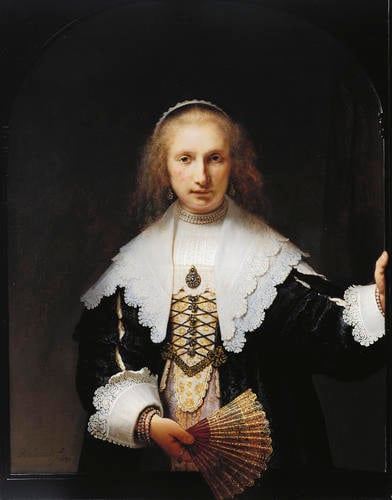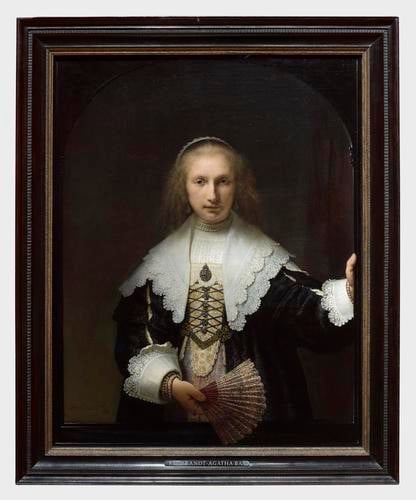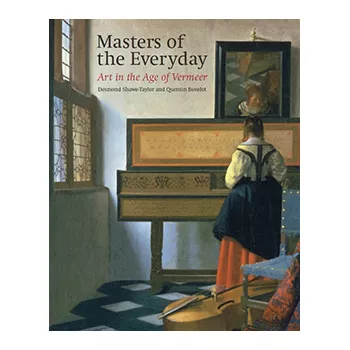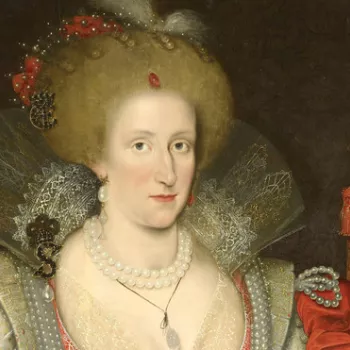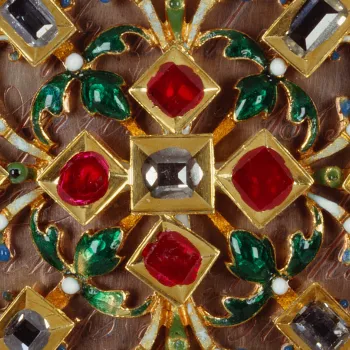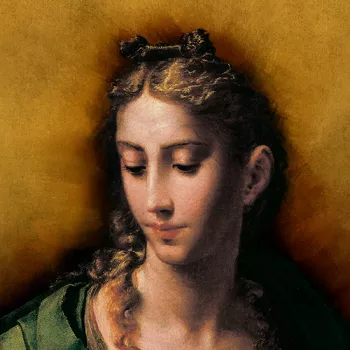Agatha Bas (1611-1658) Signed and dated 1641
Oil on canvas | 105.4 x 83.9 cm (support, canvas/panel/stretcher external) | RCIN 405352
-
This is one of the most beautiful portraits in the Royal Collection. Its companion, in the Musée Royal des Beaux-Arts, Brussels, depicts the husband of Agatha Bas (1611-58), the wool merchant Nicolaes van Bambeeck (1596-1661) The portraits are also signed and dated 1641, three years after their marriage. The couple lived in the Sint Anthoniesbreestraat, where Rembrandt himself lived from 1631; they were almost certainly known to the artist.
Rembrandt introduced a new compositional device in this painting: the figure is posed within a painted ebony frame which blurs the boundaries between the imaginary space within the composition and the real world outside. The sense of direct contact with the sitter is achieved partly through the striking gesture of the hand resting against the frame and partly by showing the fan protruding over the edge towards the viewer's space. An earlier reduction in the size of the canvas has considerably reduced this illusionistic effect. The different levels of finish in the painting are particularly striking. For instance, Rembrandt portrays the fine hairs at the edge of the hairline through curling lines incised into the paint with the end of the brush, and in contrast to such direct handling the depiction of Agatha Bas's skin and eyes is remarkably subtle and delicate.
Agatha's dress consists of a black gown worn over a stomacher of which silk patterned with gold flowers and decorated with diagonal black laces. She wears a pale pink silk skirt and carries a fashionable folding fan prominently displayed. Multiple strands of pearls adorn her wrists and neck. Around her neck she wears a collar, partlet and kerchief, each trimmed with lace. Slight indentations of the folded edges of the kerchief suggest it has been pinned into position. Technical examination of the painting reveals that Rembrandt has painted this lace in different ways. In some areas he paints the delicate pattern of the lace in thick white pigment against a dark background, whereas in others in fills a broad area with white paint then used a darker paint to fill in the negative space.
There are five paintings by Rembrandt in the Royal Collection, the earliest of which, The Artist's Mother(?), was presented to Charles I before 1633, and was thus one of the first works by Rembrandt to reach England. Of the three Rembrandts collected by George IV, The Shipbuilder and his Wife, purchased for 5,000 guineas in 1811, was perhaps his most famous single acquisition.
Signed and dated: 'Rembrandt f. / 1641' and inscribed with the sitter's age: 'AE 29'
Catalogue entry from Royal Treasures, A Golden Jubilee Celebration, London 2002Provenance
Louis Bernard Coclers (Amsterdam), 1805; imported into England by Nieuwenhuys and offered at Christie's, London, 29 June 1814 (76); bought in; subsequently bought by John Smith; by whom sold to Lord Charles Townshend; his sale, Robins, London, 4 June 1819 (32); bought by Lord Yarmouth for George IV at anonymous sale; added to the inventories of Carlton House dated 1816 (no 562) and 1819 (no 549); in the Picture Gallery at Buckingham Palace in 1841 (no 10)
-
Medium and techniques
Oil on canvas
Measurements
105.4 x 83.9 cm (support, canvas/panel/stretcher external)
122.4 x 100.4 x 8.0 cm (frame, external)
Other number(s)
Alternative title(s)
Portrait of a lady with a fan, traditionally identified as




